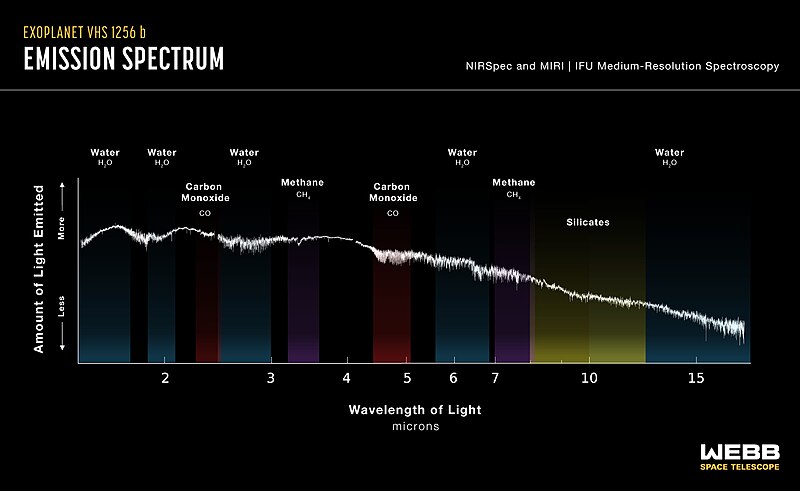File:Exoplanet VHS 1256 b (NIRSpec and MIRI emission spectrum) (weic2308b).jpg
From Wikimedia Commons, the free media repository
Jump to navigation
Jump to search

Size of this preview: 800 × 491 pixels. Other resolutions: 320 × 196 pixels | 640 × 393 pixels | 1,024 × 628 pixels | 1,280 × 785 pixels | 2,560 × 1,571 pixels | 3,840 × 2,356 pixels.
Original file (3,840 × 2,356 pixels, file size: 479 KB, MIME type: image/jpeg)
File information
Structured data
Captions
Captions
Add a one-line explanation of what this file represents
Summary
[edit]| DescriptionExoplanet VHS 1256 b (NIRSpec and MIRI emission spectrum) (weic2308b).jpg |
English: A research team led by Brittany Miles of the University of Arizona used two instruments known as spectrographs aboard the James Webb Space Telescope, one on its Near Infrared Spectrograph (NIRSpec) and another on its Mid-Infrared Instrument (MIRI), to observe a vast section of near- to mid-infrared light emitted by the planet VHS 1256 b. They plotted the light on the spectrum, identifying signatures of silicate clouds, water, methane and carbon monoxide. They also found evidence of carbon dioxide.[Image Description: Graphic titled “Exoplanet VHS 1256 b Emission Spectrum.” The label at top right reads NIRSpec and MIRI, IFU Medium-Resolution Spectroscopy. The spectrum is plotted on a graph with y- and x-axes. The graph shows jagged lines. There are labels for water, carbon monoxide, methane, and silicates.] |
| Date | 22 March 2023 (upload date) |
| Source | Exoplanet VHS 1256 b (NIRSpec and MIRI emission spectrum) |
| Author | NASA, ESA, CSA, J. Olmsted (STScI), B. Miles (University of Arizona), S. Hinkley (University of Exeter), B. Biller (University of Edinburgh), A. Skemer (University of California, Santa Cruz) |
| Other versions |
|
Licensing
[edit]| ESA/Webb images, videos and web texts are released by the ESA under the Creative Commons Attribution 4.0 International license and may on a non-exclusive basis be reproduced without fee provided they are clearly and visibly credited. Detailed conditions are below; see the ESA copyright statement for full information. For images created by NASA or on the webbtelescope.org website, use the {{PD-Webb}} tag.
Conditions:
Notes:
|
 |
This file is licensed under the Creative Commons Attribution 4.0 International license.
Attribution: NASA, ESA, CSA, J. Olmsted (STScI), B. Miles (University of Arizona), S. Hinkley (University of Exeter), B. Biller (University of Edinburgh), A. Skemer (University of California, Santa Cruz)
- You are free:
- to share – to copy, distribute and transmit the work
- to remix – to adapt the work
- Under the following conditions:
- attribution – You must give appropriate credit, provide a link to the license, and indicate if changes were made. You may do so in any reasonable manner, but not in any way that suggests the licensor endorses you or your use.
File history
Click on a date/time to view the file as it appeared at that time.
| Date/Time | Thumbnail | Dimensions | User | Comment | |
|---|---|---|---|---|---|
| current | 15:46, 22 March 2023 |  | 3,840 × 2,356 (479 KB) | OptimusPrimeBot (talk | contribs) | #Spacemedia - Upload of https://cdn.esawebb.org/archives/images/large/weic2308b.jpg via Commons:Spacemedia |
You cannot overwrite this file.
File usage on Commons
There are no pages that use this file.
Metadata
This file contains additional information such as Exif metadata which may have been added by the digital camera, scanner, or software program used to create or digitize it. If the file has been modified from its original state, some details such as the timestamp may not fully reflect those of the original file. The timestamp is only as accurate as the clock in the camera, and it may be completely wrong.
| Source | ESA/Webb |
|---|---|
| Credit/Provider | NASA, ESA, CSA, J. Olmsted (STScI), B. Miles (University of Arizona), S. Hinkley (University of Exeter), B. Biller (University of Edinburgh), A. Skemer (University of California, Santa Cruz) |
| Short title |
|
| Image title |
|
| Usage terms |
|
| Date and time of data generation | 15:00, 22 March 2023 |
| JPEG file comment | A research team led by Brittany Miles of the University of Arizona used two instruments known as spectrographs aboard the James Webb Space Telescope, one on its Near Infrared Spectrograph (NIRSpec) and another on its Mid-Infrared Instrument (MIRI), to observe a vast section of near- to mid-infrared light emitted by the planet VHS 1256 b. They plotted the light on the spectrum, identifying signatures of silicate clouds, water, methane and carbon monoxide. They also found evidence of carbon dioxide. [Image Description: Graphic titled “Exoplanet VHS 1256 b Emission Spectrum.” The label at top right reads NIRSpec and MIRI, IFU Medium-Resolution Spectroscopy. The spectrum is plotted on a graph with y- and x-axes. The graph shows jagged lines. There are labels for water, carbon monoxide, methane, and silicates.] |
| Software used | Adobe Photoshop 24.2 (Macintosh) |
| File change date and time | 14:00, 15 March 2023 |
| Date and time of digitizing | 05:10, 15 March 2023 |
| Date metadata was last modified | 10:00, 15 March 2023 |
| Unique ID of original document | uuid:65E6390686CF11DBA6E2D887CEACB407 |
| Contact information |
ESA Office, Space Telescope Science Institute, 3700 San Martin Dr Baltimore, MD, 21218 United States |
| IIM version | 4 |
